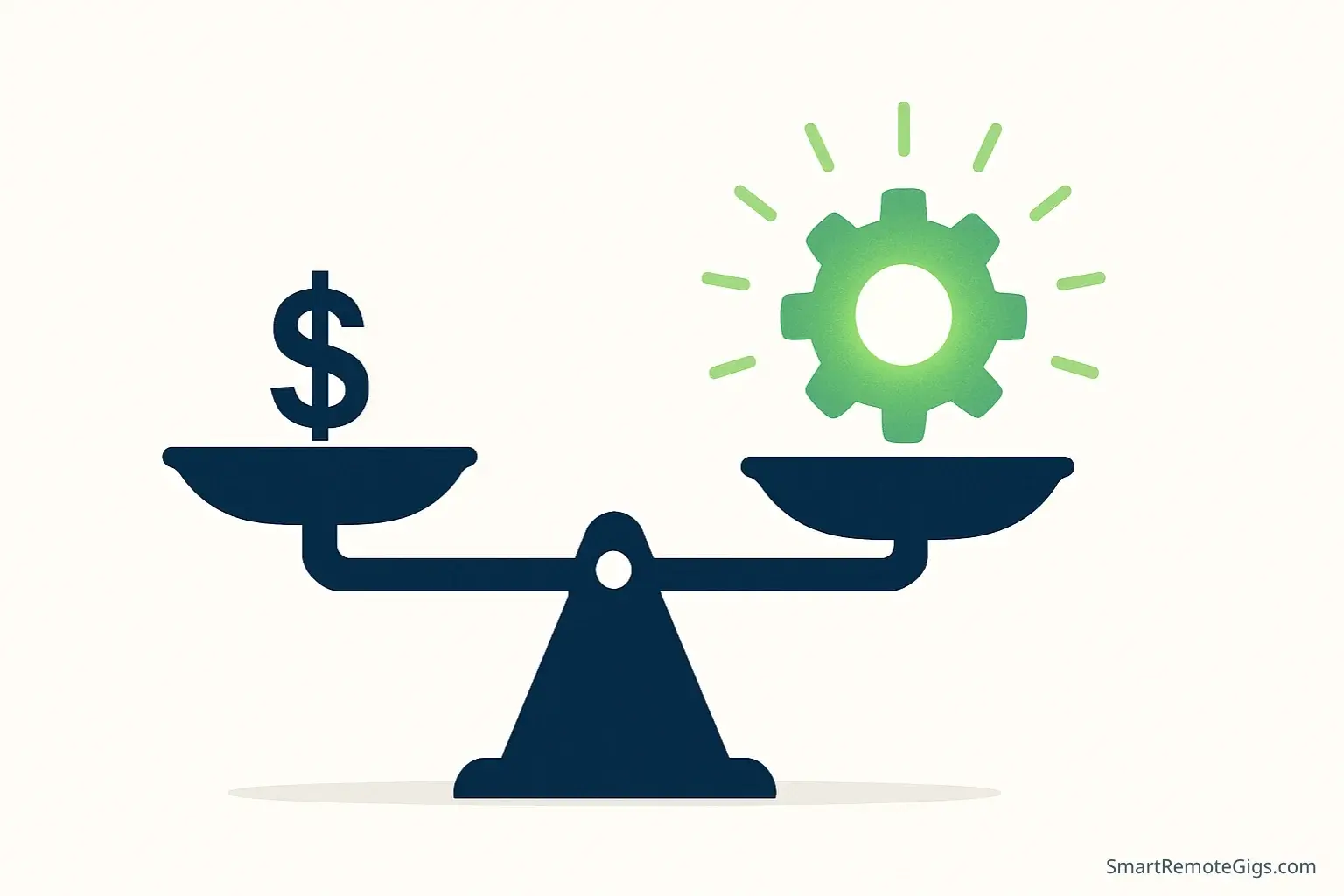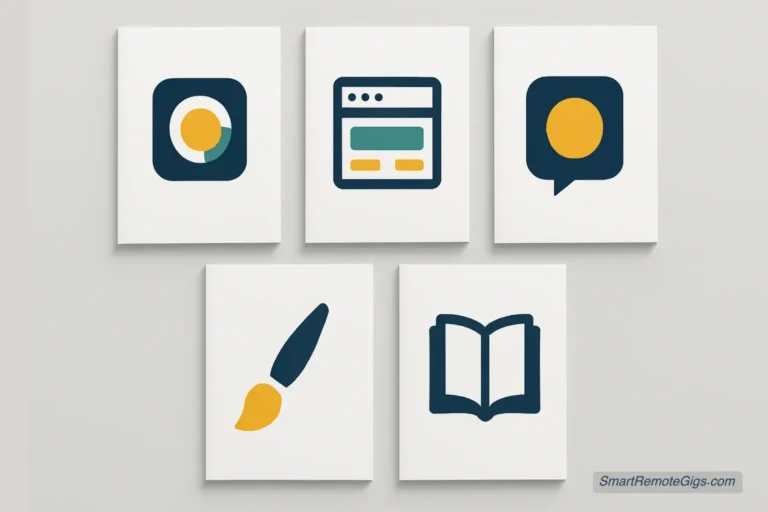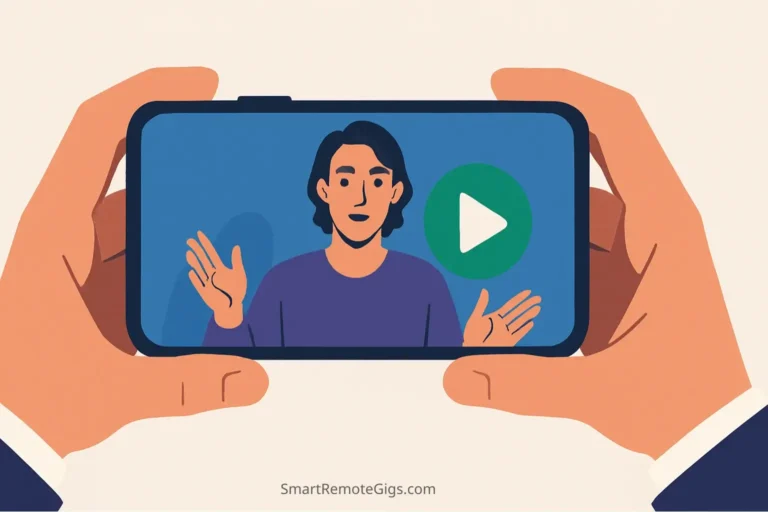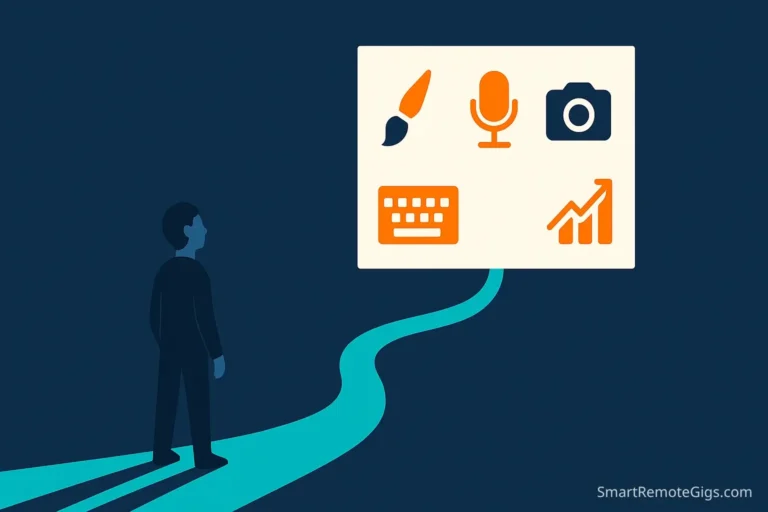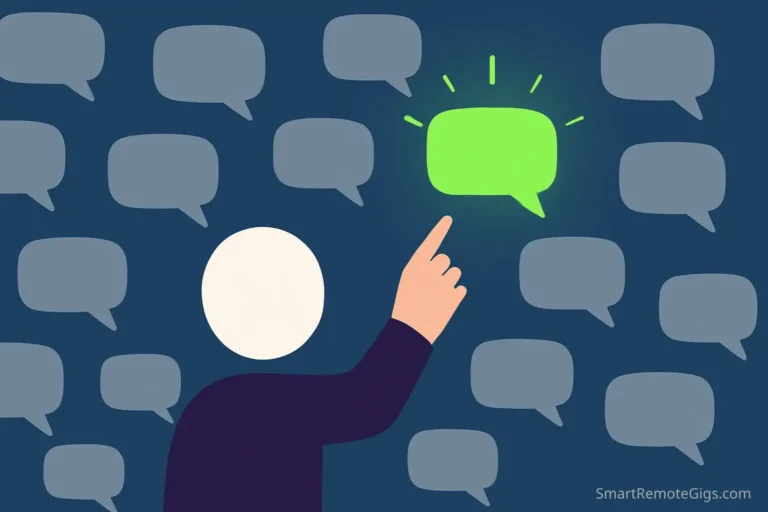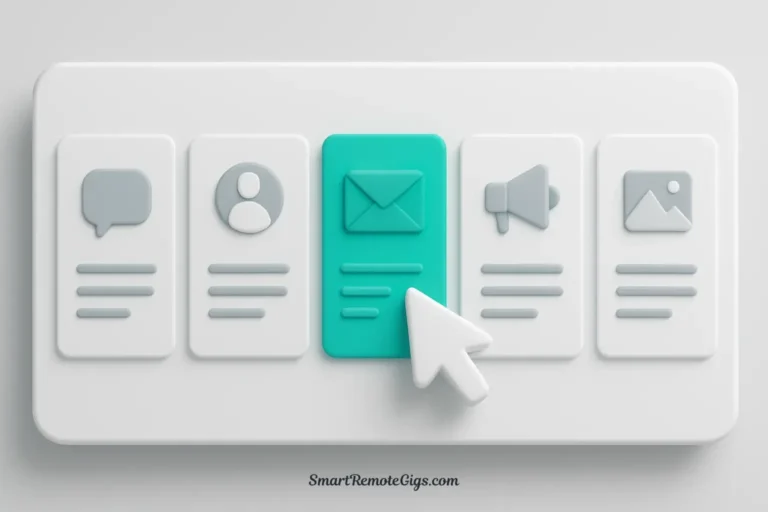“Am I too expensive? Am I too cheap?”
If you’ve spent more than five minutes setting up your first Fiverr gig, this question has probably kept you up at night. You’ve seen sellers charging $5 for what seems like hours of work, while others command $200+ for similar services. The pricing landscape on Fiverr feels like the Wild West – no rules, no logic, just pure chaos.
Here’s the truth that most “Fiverr experts” won’t tell you: the right pricing strategy isn’t about finding the perfect number. It’s about understanding buyer psychology and positioning your value in a way that makes the sale inevitable.
Whether you start at $5 or $50, success depends on how you structure your packages, communicate your value, and guide buyers toward the decision that benefits both of you. Setting your price is key to getting your first quality Fiverr client. This guide will show you exactly how to do that, backed by real psychology and proven strategies that work across every service category.
👤 About the Author: Jason Carter started his Fiverr journey with the same pricing anxiety as everyone else. By treating his gigs like a business lab, he tested every pricing model—from the $5 “foot-in-the-door” to premium-tier anchoring. This guide contains the hard-won lessons and psychological frameworks that allowed him to triple his average order value and build a sustainable six-figure freelance business.
💡 Key Pricing Principles at a Glance
- Don’t Just Sell, Guide: Use a 3-tier system (Basic, Standard, Premium) to make your target package the obvious choice.
- Price Anchoring Works: Your Premium package’s main job is to make your Standard package look like a great deal.
- Extras are Easy Profit: “Extra Fast Delivery” and “Source Files” can dramatically increase your average order value with minimal extra work.
- Raise Prices with Proof: Increase your rates after every 10 reviews and when your queue is consistently full.
Strategic Note: Before you optimize your pricing, it’s critical to ensure you’ve chosen a service with strong profit potential. A brilliant pricing strategy for a low-demand gig will still yield poor results. If you’re questioning whether your service has the potential for high-value pricing, it’s worth exploring your options.
💡 Explore High-Profit Opportunities
The most profitable services often have a low barrier to entry but high perceived value. If you’re looking for ideas with strong earning potential from day one, our guide is the perfect place to start.➡️ Discover your next profitable gig: 10 Profitable Fiverr Gig Ideas for Beginners
The Great Debate: The Pros and Cons of a $5 “Entry” Gig
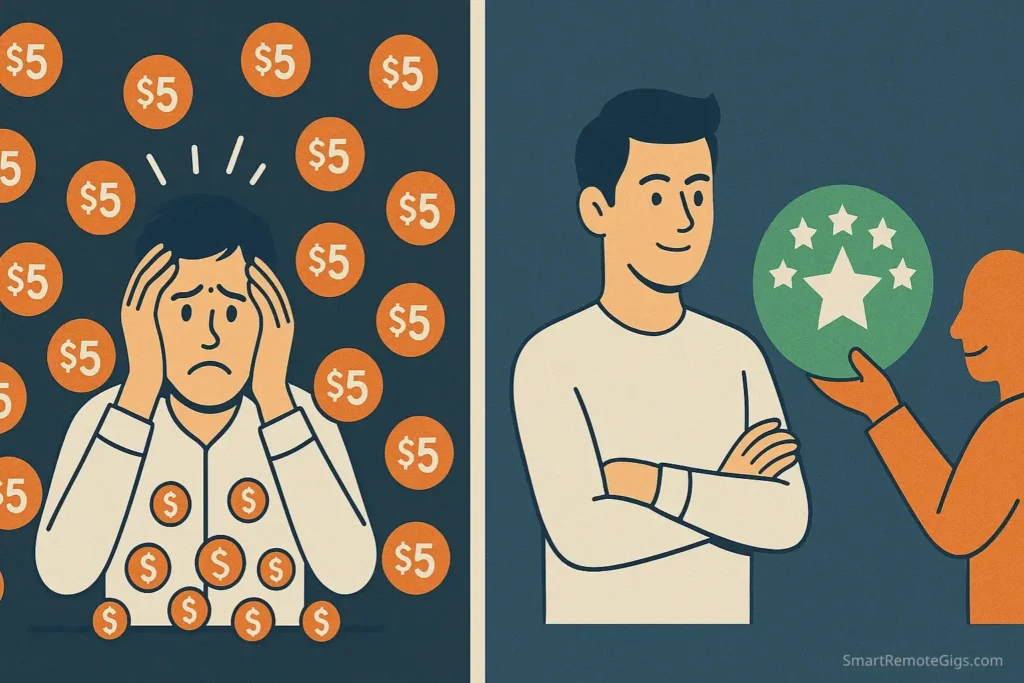
The $5 starting price is Fiverr’s original hook, but it’s also the source of endless frustration for new sellers. Should you embrace it or avoid it entirely? The answer depends on your goals, your competition, and your ability to execute a smart pricing strategy.
Pros: The Foot-in-the-Door Tactic
Lower Buyer Risk = Higher Conversion Rates
When someone has never heard of you, $5 feels like pocket change. The psychological barrier to trying your service drops to almost zero. A buyer might think, “Even if this is terrible, I’m only out five bucks.” This low-risk entry point can be incredibly powerful for generating your first few reviews.
Quick Path to Social Proof
Your first review is worth its weight in gold. It transforms you from “random stranger” to “someone who delivers.” That psychological shift is massive. A $5 gig that delivers excellent value can generate a 5-star review faster than a $50 gig where expectations are higher.
Algorithm Boost from Early Orders
Fiverr’s algorithm favors active sellers with recent orders. A few $5 orders can jumpstart your visibility in search results, leading to higher-priced opportunities down the line.
Cons: The Race to the Bottom
Attracts Price-Shopping Buyers
Buyers who choose the cheapest option are often the most demanding clients. They expect premium results at bargain prices and are more likely to leave negative reviews when their unrealistic expectations aren’t met. These aren’t the clients who build sustainable businesses.
Creates Pricing Expectations That Are Hard to Escape
Once you’re known as “the $5 person,” raising prices becomes a psychological challenge. Buyers expect you to stay in that price range, and transitioning to higher rates requires essentially rebuilding your reputation.
Unsustainable Workload vs. Income
At $5 per order (with Fiverr taking 20%), you’re earning $4 per project. Even simple tasks take time, and complex work at this rate quickly becomes charity work. This model only works if you have a clear plan to scale up quickly.
The Verdict: A $5 starting price can work as a temporary strategy if you have a clear plan to increase prices based on reviews and demand. It fails when it becomes your permanent pricing model.
The 3-Tier Package: Your Secret to Maximizing Every Order
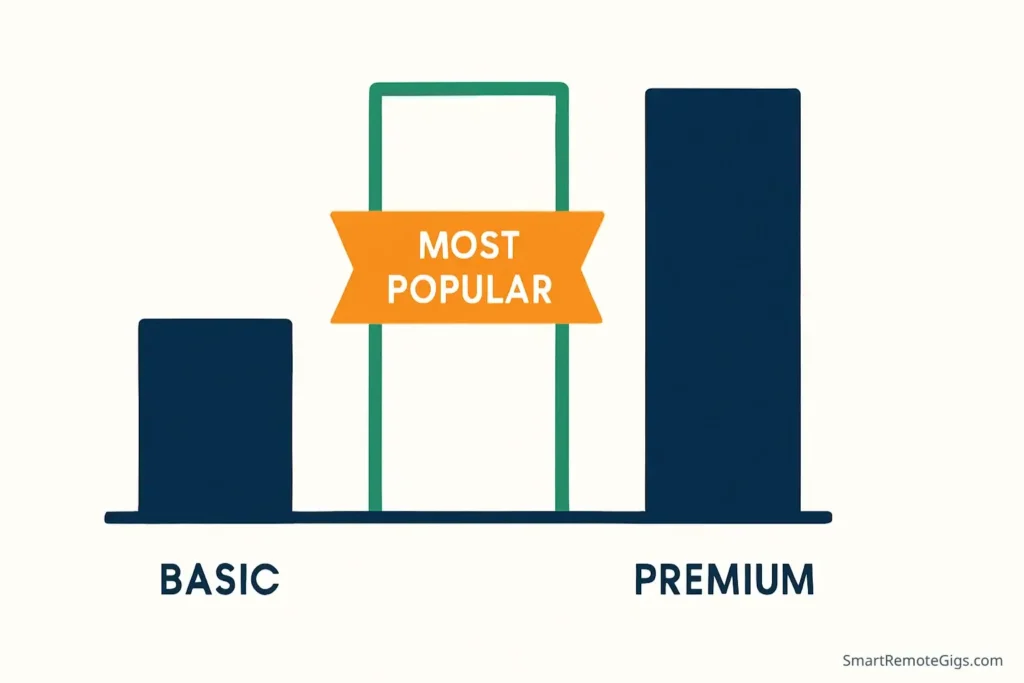
The most successful Fiverr sellers don’t just offer a service – they offer choice. The three-tier package system leverages psychological principles that naturally guide buyers toward higher-value purchases.
The Basic Package (The Lure): A Low-Risk Sample of Your Work
Your basic package isn’t designed to make money – it’s designed to remove friction from the buying decision. This package should deliver genuine value while creating natural demand for upgrades.
Basic Package Strategy:
- Price it competitively (this might be your $5-15 entry point)
- Include core deliverables with clear limitations
- Make the value obvious but leave room for natural upgrades
- Set realistic timelines that you can easily meet or beat
Example for Copywriters:
- Basic: “I will write one compelling 300-word product description with one revision included. Delivered in 2 days.”
- What it does: Solves the buyer’s immediate problem while naturally creating demand for more descriptions, faster delivery, or additional revisions.
Example for Logo Designers:
- Basic: “I will design one professional logo concept with 2 revisions. Files delivered in PNG format.”
- What it does: Gives them a great logo while creating natural demand for multiple concepts, additional file formats, or brand packages.
The Standard Package (The Target): The One You Actually Want Them to Buy
This is your Goldilocks package – not too basic, not too premium, but just right. Price this package to be your primary profit center while delivering exceptional value that feels like a steal compared to the premium option.
Standard Package Psychology:
- Price it 2-3x higher than basic (if basic is $10, standard should be $25-30)
- Include everything most buyers actually need
- Add time-saving bonuses that cost you little but add perceived value
- Position it as the “most popular” choice
Example for Copywriters:
- Standard: “I will write 3 compelling product descriptions (up to 400 words each) with unlimited revisions, competitor analysis, and SEO keyword integration. Delivered in 3 days.”
- Why it works: Solves the complete problem (multiple descriptions), removes revision anxiety, adds valuable bonuses, and offers reasonable timing.
Example for Logo Designers:
- Standard: “I will design 3 unique logo concepts with unlimited revisions, deliver files in 5 formats (PNG, JPG, PDF, AI, PSD), and include a basic brand color palette. Delivered in 4 days.”
- Why it works: Provides choice (3 concepts), removes revision limits, includes technical necessities (multiple formats), and adds a valuable bonus.
The Premium Package (The Anchor): Making Standard Look Like a Great Deal
Your premium package serves a psychological function: it makes your standard package appear to be excellent value. This is called the anchoring effect – when presented with a high-priced option, moderate prices suddenly seem reasonable.
Premium Package Strategy:
- Price it 2-3x higher than standard
- Include everything in standard plus luxury additions
- Add services that showcase your expertise
- Include premium support or faster delivery
Example for Copywriters:
- Premium: “I will write 5 compelling product descriptions (up to 500 words each) with unlimited revisions, competitor analysis, SEO keyword integration, A/B testing variations, performance optimization consultation, and priority support. Delivered in 1 day.”
- The psychology: When buyers see this $75-100 package, your $25-30 standard package suddenly looks like incredible value.
Example for Logo Designers:
- Premium: “I will design 5 unique logo concepts with unlimited revisions, deliver files in 10+ formats, include complete brand identity package (business cards, letterhead templates), provide brand usage guidelines, and offer 30 days of post-delivery support. Delivered in 2 days.”
- The psychology: This $150-200 package makes your $50-75 standard package feel like a bargain.
Beyond the Tiers: How to Use Gig Extras for Easy Upsells
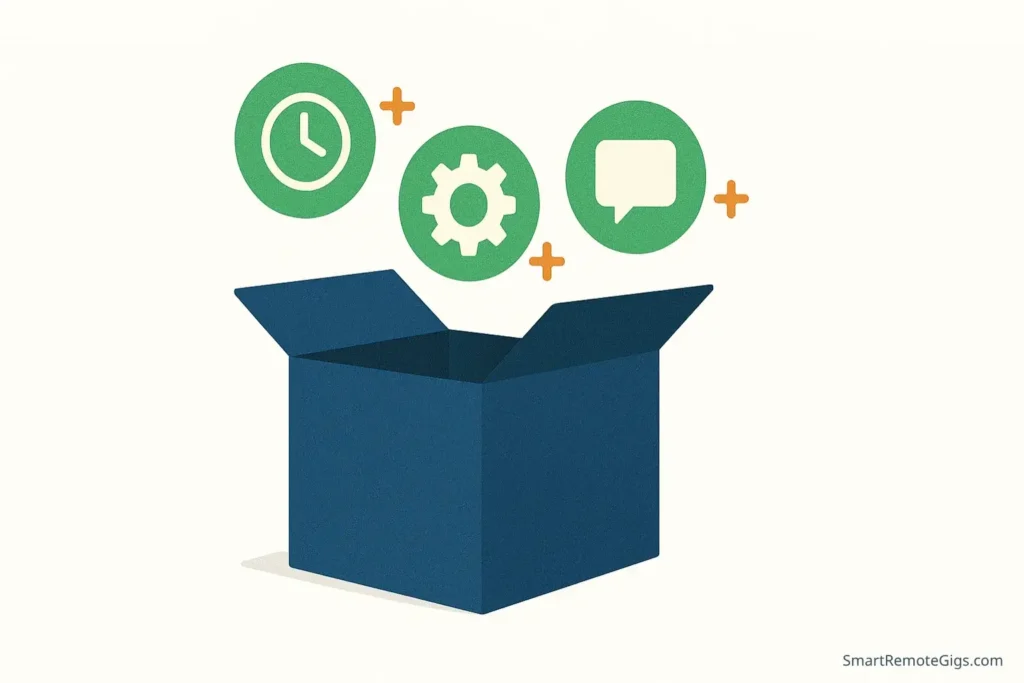
Gig extras are your secret weapon for increasing order value without raising base prices. They allow buyers to customize their purchase while giving you additional revenue streams from every order.
High-Converting Gig Extras:
⚡ Extra Fast Delivery
- Add 50-100% to your base price for 24-hour delivery
- Works because urgency creates premium value
- Only offer this if you can genuinely deliver without compromising quality
🔄 Additional Revisions
- Charge $5-15 for extra revision rounds beyond what’s included
- Removes buyer anxiety about getting it perfect
- Creates additional revenue from perfectionist clients
📱 Additional File Formats
- Charge $10-20 for source files or additional formats
- High perceived value, minimal additional work for you
- Especially valuable for design and media services
📞 Priority Support/Consultation
- Charge $15-30 for phone/video calls or priority messaging
- Positions you as a consultant, not just a service provider
- Creates deeper client relationships that lead to repeat business
🎯 Additional Deliverables
- “Add 2 more logo concepts for $20”
- “Include social media graphics for $25”
- “Add email sequence for $35”
- Scales your base service into larger projects
Industry-Specific Extras:
For Writers:
- Rush delivery, SEO optimization, social media adaptations, competitor research
For Designers:
- Source files, additional concepts, social media sizing, brand guidelines
For Marketers:
- Campaign setup, A/B testing, performance analysis, strategy consultation
For Video Editors:
- Color grading, motion graphics, multiple aspect ratios, raw footage delivery
When and How to Raise Your Prices
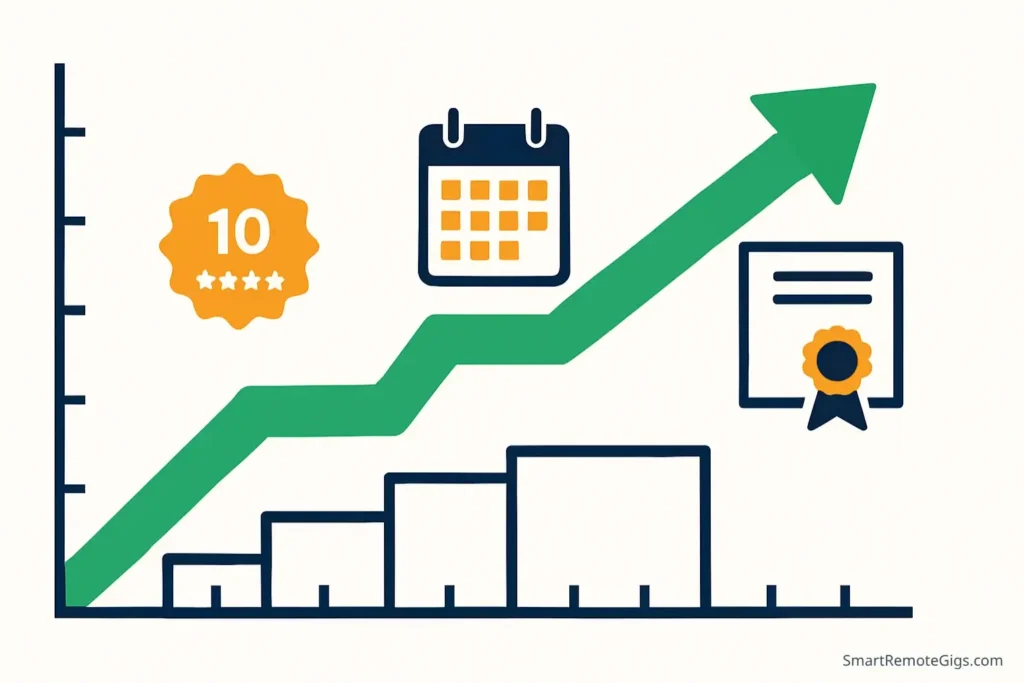
Pricing isn’t static. As you build reputation, skills, and demand, your prices should evolve. Here’s when and how to make these transitions strategically.
The Price Increase Checklist
✅ After Your First 10 Reviews
Once you have social proof, you’ve earned the right to charge more. Increase your prices by 25-50% and monitor how it affects your order volume.
✅ When Your Queue is Consistently Full
If you’re booked solid for more than a week, you’re underpriced. Raise your rates until supply and demand balance out.
✅ When You’ve Mastered Efficiency
As you get faster and better at your service, you can maintain quality while increasing prices. Your hourly rate should improve with experience.
✅ After Significant Skill Upgrades
Completed a certification? Learned new software? Added a valuable skill? These justify immediate price increases.
✅ When Competitors Are Charging More
Regularly research what similar sellers charge. If you’re significantly below market rate with similar or better reviews, you’re leaving money on the table.
How to Raise Prices Without Losing Clients
The Grandfather Method:
Keep existing regular clients at their current rates while charging new clients higher prices. This maintains relationships while allowing growth.
The Package Restructure:
Instead of raising prices on existing packages, create new “premium” versions with additional value while keeping basic options available.
The Seasonal Adjustment:
Raise prices during high-demand periods (end of year for business services, summer for vacation-related services) and maintain higher rates afterward.
The Communication Strategy:
For existing clients, send a professional message 30 days before implementing increases:
“Hi [Name], I wanted to give you advance notice that I’ll be updating my pricing structure starting [date] to reflect increased demand and additional services I’m now offering. I value our working relationship and wanted to make sure you’re aware of these changes. If you have any upcoming projects, I’d be happy to honor current rates if ordered before [date].”
Testing Price Changes
A/B Testing Approach:
Create identical gigs with different prices to test buyer response. Run both for 2-3 weeks and analyze conversion rates, not just order volume.
The Gradual Increase:
Raise prices in small increments (10-20%) rather than large jumps. This allows you to find the sweet spot without shocking potential buyers.
Monitor Key Metrics:
- Conversion Rate: Views to orders ratio
- Message to Order Rate: How many inquiries turn into sales
- Average Order Value: Including gig extras
- Client Quality: Review ratings and communication experience
Advanced Pricing Psychology: Making Higher Prices Feel Like Better Value
The Decoy Effect in Action
When structuring your three-tier system, make your standard package obviously better value than basic, while premium serves as the expensive decoy that makes standard look reasonable.
Example Structure:
- Basic: 1 logo, 2 revisions, PNG only – $15
- Standard: 3 logos, unlimited revisions, 5 file formats, color palette – $45
- Premium: 5 logos, unlimited revisions, 10 file formats, brand package, consultation – $120
The premium package makes $45 feel reasonable, while the basic package makes buyers realize they need more than the minimum.
Price Anchoring Beyond Packages
Start High in Negotiations:
When buyers message asking for custom quotes, start higher than your target price. This anchors their expectations and makes your actual price feel like a concession.
Reference Premium Alternatives:
“Agencies charge $500+ for this service, but I can deliver the same quality for $75 because I have lower overhead.”
Emphasize Time Savings:
“This normally takes businesses weeks to figure out. I’ll have it done in 2 days, saving you time and frustration.”
The Subscription Mindset
Frame ongoing services in terms of monthly value rather than per-project cost:
“For less than $2 per day, I’ll manage all your social media content” sounds better than “$50 per month for social media management.”
Common Pricing Mistakes That Kill Sales
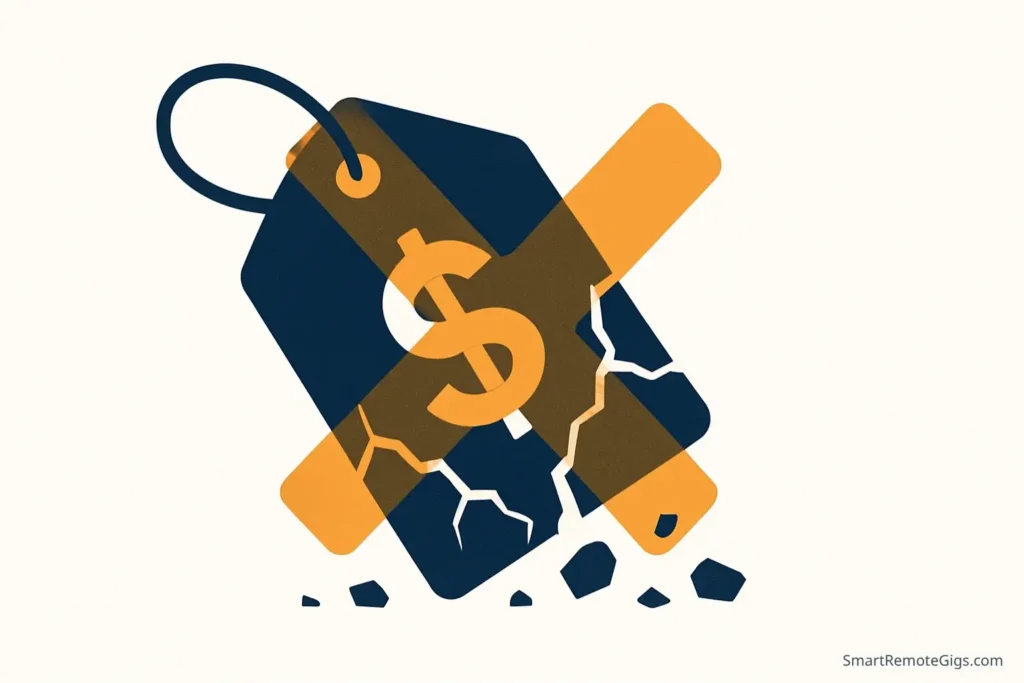
Mistake #1: Pricing Based on Your Financial Situation
Your personal need for money shouldn’t determine your prices. Desperate pricing attracts bad clients and devalues your service category.
Mistake #2: Only Competing on Price
If price is your only competitive advantage, you’ll always be vulnerable to someone cheaper. Compete on value, quality, service, or specialization instead.
Mistake #3: Not Testing Different Price Points
Most sellers set prices once and never experiment. Regular testing reveals opportunities for higher profits with better clients.
Mistake #4: Ignoring Package Psychology
Single-price offerings leave money on the table. The three-tier system almost always generates higher average order values.
Mistake #5: Raising Prices Without Adding Value
Price increases should coincide with genuine improvements in service, quality, or deliverables. Pure price hikes without additional value create client resentment.
Your Pricing Action Plan
Week 1: Research and Analysis
- Study 20+ competitors in your category
- Note their pricing structures and package offerings
- Identify gaps in the market where you can position yourself
Week 2: Package Development
- Create your three-tier package structure
- Develop 5-7 relevant gig extras
- Write compelling descriptions that emphasize value, not features
Week 3: Testing and Launch
- Launch with conservative pricing to generate initial reviews
- A/B test different price points on similar gigs
- Monitor conversion rates and buyer quality
Week 4: Optimization
- Analyze which packages sell most frequently
- Adjust pricing based on demand and competition
- Plan your first price increase timeline
Month 2 and Beyond:
- Raise prices after every 10 new reviews
- Regularly research competitor pricing
- Continuously test new package structures and extras
The Bottom Line: Pricing as a Business Strategy
Your pricing strategy is a tool, not a prison. It should evolve with your skills, reputation, and market position. Whether you start at $5 or $50, success comes from understanding buyer psychology, delivering exceptional value, and having a clear plan for growth.
The sellers who build sustainable, profitable businesses on Fiverr aren’t necessarily the cheapest or the most expensive – they’re the ones who price strategically, communicate value effectively, and consistently deliver results that justify their rates.
You’re not just selling a service; you’re solving a problem. This is the core of value-based pricing, a strategy detailed by Harvard Business Review that the world’s most successful companies use. Price your solutions based on the value they create for the client, not the time they take you to complete. When buyers see a clear return on investment, the price becomes secondary.
Your next step: Choose one pricing strategy from this guide and implement it in the next 48 hours. Test it for two weeks, measure the results, and adjust based on what you learn. Pricing mastery comes from strategic experimentation, not perfect planning.

